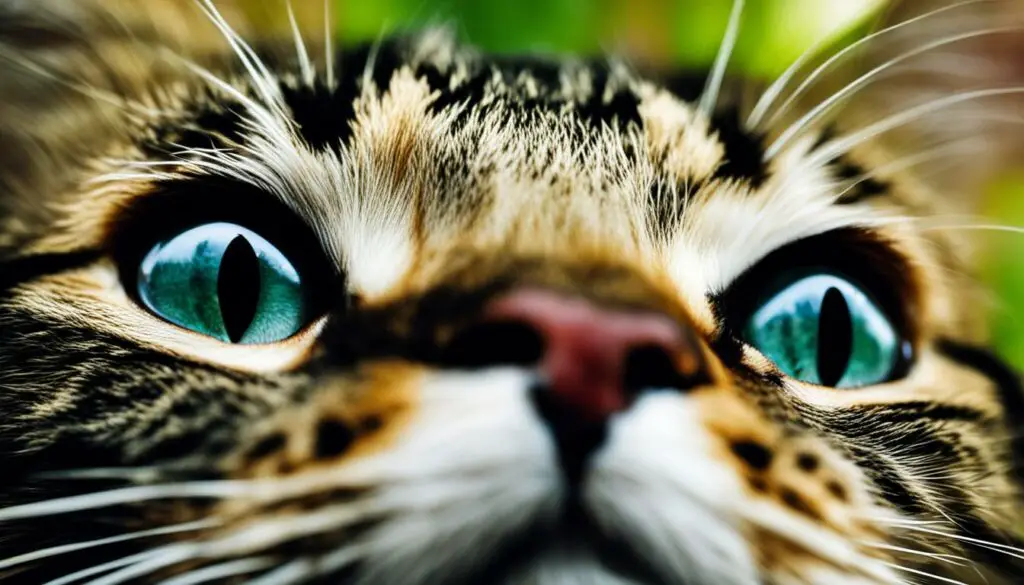Have you ever wondered why your cat nibbles on your fingers? It’s a behavior that can be both confusing and endearing. In this article, we will explore the key aspects of why cats exhibit this behavior, including their curiosity, affection, grooming instincts, and playfulness.
Understanding why cats nibble on fingers is essential for building a stronger bond with our feline companions. By unraveling the motivations behind this behavior, we can communicate better and nurture a more harmonious relationship with our cats.
Key Takeaways:
- Cats may nibble on fingers out of curiosity, affection, grooming instincts, or playfulness.
- Paying attention to your cat’s body language and communication can help decipher the reasons behind their nibbling behavior.
- Social interactions, bonding, and establishing hierarchies play a role in why cats nibble on fingers.
- Understanding the impact of environmental factors and providing proper stimulation can help prevent excessive nibbling.
- Training and behavior modification techniques, along with handling cat bites, are important aspects to consider when addressing nibbling behavior.
Understanding Cat Behavior
When it comes to understanding our feline companions, it’s crucial to delve into their behavior. Cats communicate through various means, including body language, social interactions, instinctual behaviors, and their environment. By gaining insights into these aspects of cat behavior, we can better comprehend why cats nibble on fingers and other behaviors they exhibit.
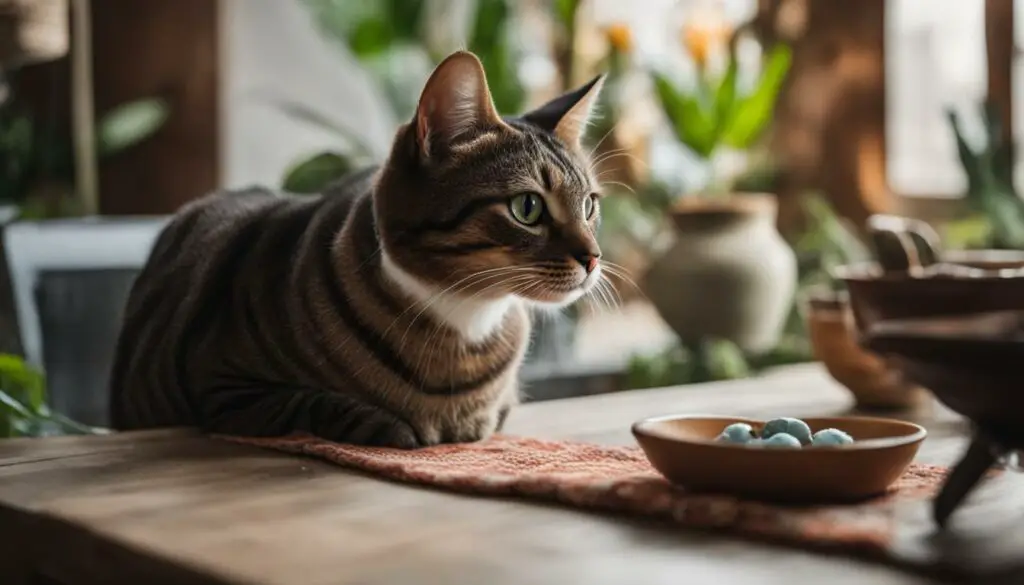
“Cats communicate through various means, including body language, social interactions, instinctual behaviors, and their environment.”
One of the key components of cat behavior is their use of body language. Cats convey their emotions and intentions through tail positions, ear movements, and overall posture. By paying close attention to these cues, we can begin to decipher what our cats are trying to communicate when they nibble on our fingers.
In addition to body language, social interactions play a vital role in cat behavior. Cats are both solitary and social animals, establishing hierarchies and territories while also forming bonds with their social groups. Nibbling on fingers can be a way for cats to establish and strengthen their bond with their human companions, reflecting their natural instincts.
Environmental Factors and Their Influence
Environmental factors also significantly impact a cat’s behavior. The availability of resources, sensory stimuli, and overall comfort can all play a role in how cats behave. Nibbling on fingers might be a way for cats to seek comfort or alleviate stress in their environment. Creating a stimulating and enriching environment for our feline friends can help reduce unwanted behaviors.
Understanding cat behavior is a vital step in building a strong and harmonious relationship with our furry companions. By considering their natural instincts, observing their body language, and providing a conducive environment, we can better address and modify behaviors like nibbling on fingers, leading to a deeper bond and mutual understanding.
Body Language and Communication
Understanding a cat’s body language is essential for decoding their communication cues. Cats use various body movements and positions to express their emotions and intentions. By observing their tail positions, ear movements, and overall posture, we can gain insights into what our feline companions are trying to convey when they nibble on our fingers.
Tail Positions: A cat’s tail can reveal a lot about their mood. When a cat’s tail is high and straight, it indicates confidence and contentment. However, if the tail is tucked between their legs, it may signal fear or anxiety. When a cat is nibbling on fingers, pay attention to their tail position to gauge their emotional state.
Ear Movements: Cats have highly expressive ears that can provide valuable information about their mood. When a cat’s ears are forward and slightly angled, it shows that they are alert and interested. However, flattened or backward ears can indicate aggression or fear. By observing their ear movements, we can better understand the context in which they nibble on our fingers.
Posture: A cat’s posture can give us clues about their level of comfort and confidence. When a cat is relaxed and at ease, their body will be loose, and they may even roll onto their back to invite play. On the other hand, if a cat’s body is tense, with their back arched and fur standing on end, it may indicate aggression or fear. Paying attention to their posture when they nibble on our fingers can help us interpret their behavior more accurately.

Understanding a cat’s body language and communication cues can deepen our bond with them and foster better understanding. By paying attention to their tail positions, ear movements, and overall posture, we can decipher their intentions when they nibble on our fingers and respond accordingly. It is important to note that each cat is unique, and their body language may vary slightly, so it is essential to observe and interpret their cues in the context of their individual personalities.
Social Interactions and Bonding
One of the key reasons why cats nibble on fingers is to engage in social interactions and strengthen their bond with their human companions. Cats are known to be both solitary and social animals, and they form hierarchies and territories within their social groups. Nibbling on fingers can be seen as a way for cats to establish and reinforce their position within their social circle and to communicate their trust and affection towards their human companions.
When cats engage in nibbling behavior, it is often accompanied by gentle purring and kneading, further emphasizing their desire for companionship and social interaction. It is important for cat owners to recognize and appreciate these gestures as a form of bonding and to respond positively to them. This can include gentle petting, offering treats or toys, and engaging in interactive play sessions to further strengthen the bond between human and feline.
The Importance of Hierarchies and Territories
Understanding hierarchies and territories is crucial in comprehending why cats nibble on fingers. Cats are instinctually driven to establish and maintain social hierarchies within their environment. They have a natural inclination to mark their territory and assert their dominance, and nibbling on fingers can be seen as an extension of this behavior.
By nibbling and lightly biting on fingers, cats are communicating their position within the hierarchy, as well as their trust and acceptance of their human companion. It is a way for them to assert their presence and establish boundaries, while also seeking companionship and interaction. By respecting these boundaries and responding appropriately, cat owners can foster a harmonious relationship based on trust and understanding.
| Key Points | Actions |
|---|---|
| Cats nibble on fingers to establish and strengthen their bond with their human companions. | Respond positively to nibbling behavior, such as gentle petting and offering treats or toys. |
| Nibbling behavior is often accompanied by purring and kneading, emphasizing the desire for companionship. | Engage in interactive play sessions to further strengthen the bond between human and feline. |
| Cats establish hierarchies and territories and use nibbling to assert their dominance and mark their territory. | Respect boundaries and respond appropriately to assertive behavior. |
Instinctual Behaviors and Playfulness
When it comes to understanding why cats nibble on fingers, it’s important to recognize their instinctual behaviors and natural playfulness. Domesticated cats still retain many traits from their wild ancestors, and these behaviors can manifest in various ways, including hunting, scratching, marking, vocalizing, and yes, even nibbling.
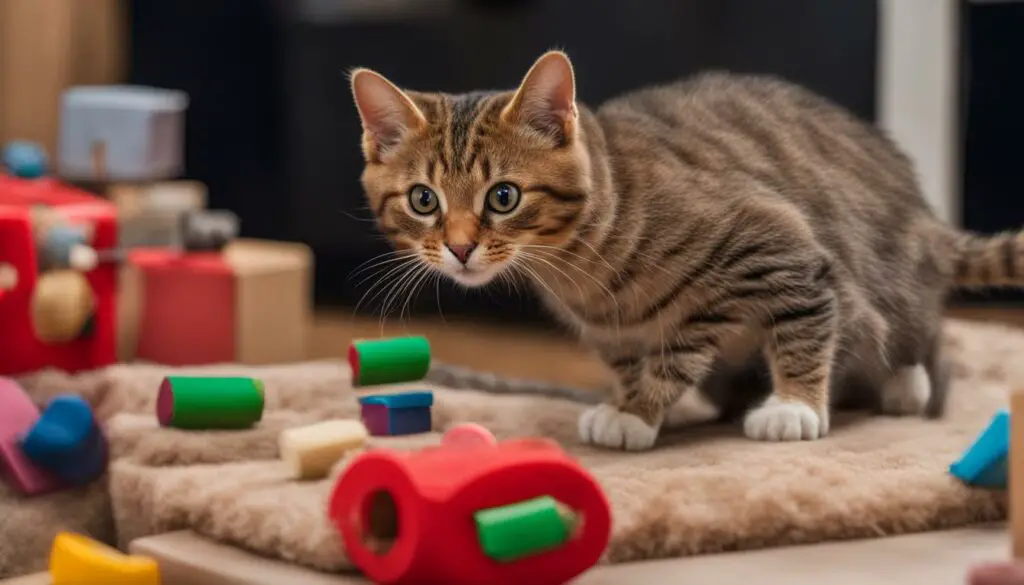
Playing is an essential part of a cat’s life, and nibbling can be a playful expression of their hunting instincts. Just like they would bite and nibble on their prey in the wild, cats may nibble on fingers as a playful way to engage with their human companions. It’s their natural way of mimicking the actions they would take while hunting in the wild, and it’s essential for their mental and physical stimulation.
Table: Common Instinctual Behaviors in Cats
| Hunting | Scratching | Marking | Vocalizing |
|---|---|---|---|
| Chasing and capturing small moving objects | Scratching surfaces to mark territory and maintain nail health | Leaving scent marks to communicate and claim their territory | Meowing, purring, hissing, growling, and other vocalizations |
While nibbling on fingers can be a playful behavior, it’s important to set boundaries and redirect their attention to appropriate toys. Providing interactive toys that stimulate their natural hunting instincts can help satisfy their need for play and prevent excessive nibbling on fingers. Additionally, regular play sessions and environmental enrichment can keep cats mentally and physically engaged, further reducing the likelihood of excessive nibbling behaviors.
Environmental Factors and Comfort
When it comes to understanding why cats nibble on fingers, we cannot overlook the impact of environmental factors on their behavior. Cats are highly sensitive to their surroundings, and their comfort level plays a significant role in determining their actions. The environment encompasses various elements, including sensory stimuli, available resources, and overall stress levels.
Cats are naturally curious creatures, and they rely on sensory stimuli to navigate and explore their surroundings. From the feel of different surfaces to the scent of objects, cats use their senses to gather information and assess their environment. When a cat nibbles on your fingers, it may be seeking comfort or stimulation through sensory feedback.
The availability of resources is another important environmental factor to consider. Cats require appropriate outlets for their natural behaviors, such as scratching posts, toys, and perches. When these resources are lacking, a cat may resort to nibbling on fingers as a way to satisfy their need for mental and physical stimulation. Providing a variety of enriching resources can help divert their attention from finger nibbling and promote a more fulfilling environment.
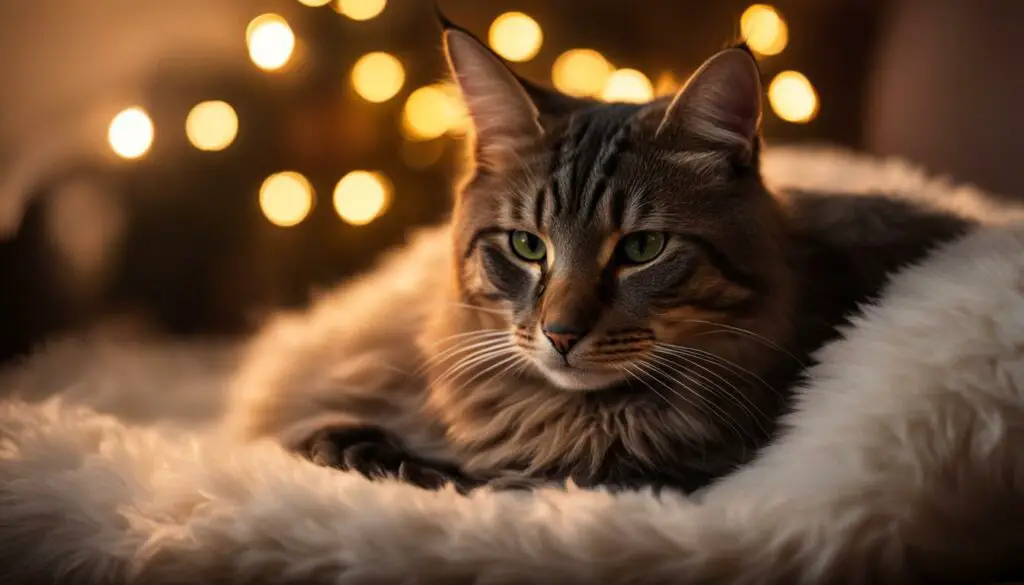
The Importance of a Stress-Free Environment
Stress can have a profound impact on a cat’s behavior, including their tendency to nibble on fingers. Cats are sensitive to changes in their environment, and stressors such as loud noises, unfamiliar people, or other animals can trigger anxiety and defensive behaviors. Creating a calm and stress-free environment for your cat is essential in reducing finger nibbling and promoting overall well-being.
“Understanding the environmental factors that contribute to finger nibbling can help us create a more fulfilling and stress-free environment for our feline friends.”
By addressing and modifying these environmental factors, we can help alleviate the urge for cats to nibble on fingers. Providing sensory enriching experiences, ensuring a variety of resources, and minimizing stressors can go a long way in creating a comfortable and content living environment for our beloved cats.
Health and Dental Issues
When cats nibble on our fingers, it’s important to consider potential health and dental issues that may be causing this behavior. One common reason for finger nibbling is teething. Just like human babies, kittens go through a teething phase where their teeth are growing and causing discomfort. Nibbling on fingers can provide them with some relief from the pain and discomfort they may be experiencing.
Aside from teething, other underlying health problems can also lead to finger nibbling. Cats may have dental issues such as gum disease or tooth decay, which can cause pain and discomfort in their mouths. In some cases, they might focus their nibbling on fingers as a way to alleviate this discomfort. It’s important to monitor your cat’s oral health and seek veterinary attention if you notice any signs of dental problems.
“Cats may nibble on fingers due to underlying health or dental issues.”
Additionally, cats may nibble on fingers if they are experiencing other health issues that cause discomfort or pain. It’s essential to observe your cat’s overall behavior and look for any signs of illness or injury. If you suspect that your cat’s finger nibbling is related to health issues, it’s always best to consult with a veterinarian for a proper diagnosis and treatment.
| Common Health and Dental Issues | Symptoms |
|---|---|
| Gum disease | Bad breath, swollen or bleeding gums |
| Tooth decay | Visible decay or dark spots on teeth |
| Teething | Chewing behaviors, swollen gums |
| Oral infections | Excessive drooling, reluctance to eat |
By addressing any underlying health or dental issues, we can help alleviate the discomfort that may be driving our cats to nibble on our fingers. Regular veterinary check-ups, proper dental care, and prompt treatment of any health issues are crucial to ensuring our furry friends‘ overall well-being.

Aggression and Anxiety
Cats may exhibit nibbling on fingers as a result of aggression and anxiety. When a cat feels threatened or fearful, they may resort to defensive behaviors, such as nibbling or biting. It’s important to understand the underlying causes of aggression and anxiety in cats to address and manage these behaviors effectively.
One common cause of aggression in cats is a lack of proper socialization. Cats that have not been adequately exposed to different people, animals, and environments may feel anxious or fearful in unfamiliar situations, leading to defensive behavior like nibbling. Socialization from an early age, through positive interactions and gradual exposure to new stimuli, is crucial in preventing aggression.
Additionally, anxiety in cats can result from various factors, such as changes in their environment, lack of stimulation, or past traumatic experiences. Cats rely on their surroundings for comfort and security, and any disruptions or perceived threats can trigger anxiety-related behaviors like nibbling. Providing a consistent and enriching environment, with access to toys, scratching posts, and perches, can help alleviate anxiety and reduce aggressive tendencies.
Recognizing Anxiety-Related Aggression
In order to effectively address anxiety-related aggression in cats, it’s important to be able to recognize the signs. Some common indicators of anxiety in cats include:
- Excessive grooming or over-grooming
- Restlessness and pacing
- Excessive vocalization
- Increased hiding or avoidance behaviors
If you notice these signs in your cat, it’s important to consult with a veterinarian or a professional animal behaviorist to develop a tailored plan for managing their anxiety and aggression. They can provide guidance on behavior modification techniques, such as positive reinforcement training, and help create a safe and calm environment for your cat.
| Signs of Anxiety-Related Aggression | Management Strategies |
|---|---|
| Excessive grooming or over-grooming | Provide interactive toys and engage in play sessions to redirect their focus and provide mental stimulation. |
| Restlessness and pacing | Create a calm and secure environment with designated resting areas and hiding spots. |
| Excessive vocalization | Identify and address any underlying triggers for vocalization, such as environmental stressors. |
| Increased hiding or avoidance behaviors | Gradually introduce your cat to new experiences and people to build confidence and reduce avoidance behaviors. |
Managing aggression and anxiety in cats requires patience, consistency, and understanding. By addressing the underlying causes and providing a nurturing environment, you can help your cat feel safe and secure, reducing the likelihood of nibbling behaviors.
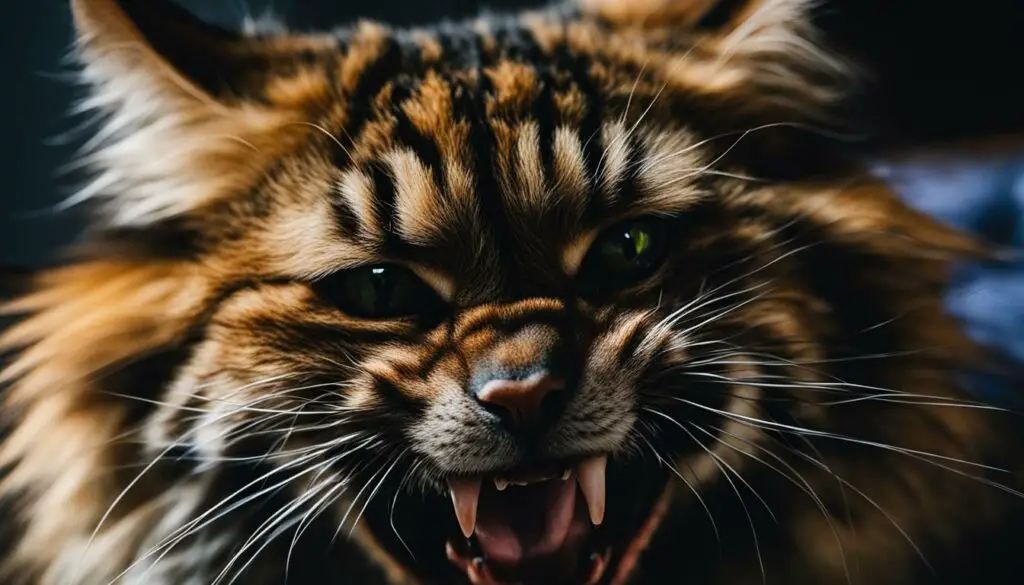
Quote: “Aggression in cats is often a sign of fear, not dominance. Understanding and addressing the root cause of their anxiety is essential in promoting a peaceful coexistence.” – Cat Behavior Expert
Section 9: Boredom and Stimulation
When it comes to understanding why cats nibble on fingers, it is important to consider the role of boredom and stimulation. Like humans, cats can become restless and seek out activities to keep themselves entertained. Without adequate mental and physical stimulation, they may resort to nibbling on fingers as a way to alleviate their boredom.
One effective way to combat boredom is by providing interactive toys for your cat. These toys engage their natural hunting instincts and keep them mentally stimulated. Look for toys that allow your cat to bat, chase, and pounce, as these actions mimic their natural behaviors. Interactive toys not only provide entertainment but also help to redirect your cat’s attention away from nibbling on fingers.
“Engaging your cat in regular play sessions is crucial for preventing boredom-related behaviors like nibbling. Try using interactive feather wands, laser pointers, or treat-dispensing puzzles to keep your cat mentally and physically engaged.”
In addition to interactive toys, regular play sessions with your cat are essential. Set aside dedicated time each day to engage in play activities. This can involve playing with toys, using laser pointers, or engaging in interactive games. These play sessions not only provide stimulation but also strengthen the bond between you and your cat, creating a more fulfilling and enriching environment for them.
Another great way to combat boredom is by creating an enriching environment for your cat. Ensure they have access to scratching posts, perches, and hiding spots. These environmental features provide mental stimulation and allow them to engage in natural behaviors like climbing and scratching.
Table: Cat-Friendly Interactive Toys
| Toy Name | Description |
|---|---|
| Feather Wand | A wand with feathers attached, encourages chasing and pouncing. |
| Laser Pointer | Projects a laser dot for your cat to chase, providing exercise and mental stimulation. |
| Treat-Dispensing Puzzle | A toy that requires your cat to solve puzzles to access treats, keeping them mentally engaged. |
| Motion-Activated Toys | Toys that activate when your cat interacts with them, stimulating their curiosity and playfulness. |
Remember, boredom can contribute to nibbling behaviors in cats. By providing interactive toys, engaging in regular play sessions, and creating an enriching environment, you can help alleviate boredom and redirect your cat’s attention away from nibbling on fingers.
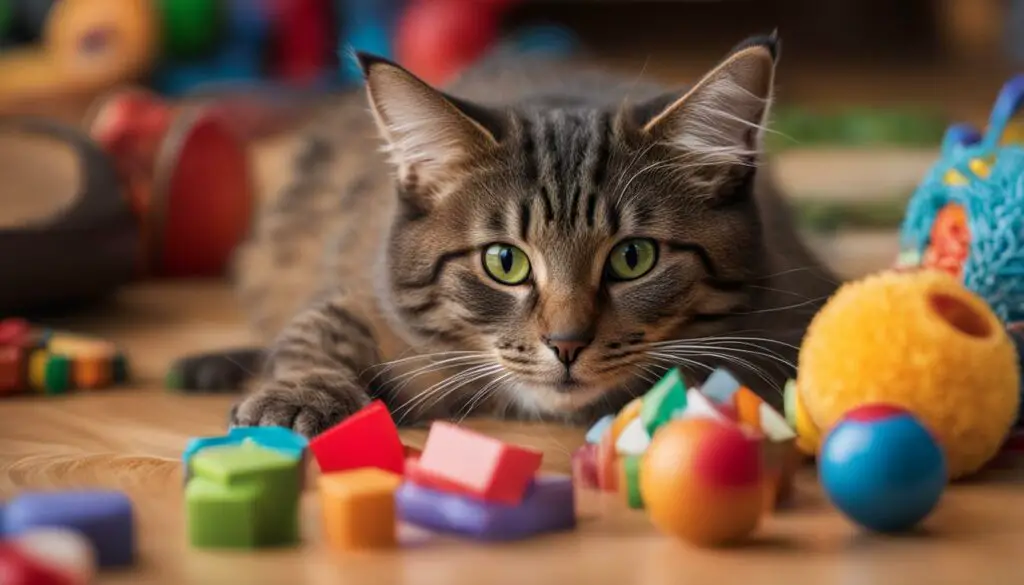
Training and Behavior Modification
When it comes to addressing cat nibbling behavior, training and behavior modification techniques can be effective tools. By using positive reinforcement and consistency, we can guide our cats towards alternative behaviors and discourage excessive nibbling on fingers.
Positive reinforcement involves rewarding desired behaviors with treats, praise, or playtime. This technique helps cats associate the desired behavior with a positive outcome, making them more likely to repeat it. For example, if your cat starts to nibble on your fingers, gently redirect their attention to a suitable toy or scratching post. When they engage with the toy or post instead of your fingers, reward them with a treat or verbal praise. Over time, they will learn that playing with the toy or using the scratching post is more rewarding than nibbling on fingers.
Consistency is key when using training and behavior modification techniques. It is important to set clear boundaries and consistently reinforce the desired behavior. Avoid rewarding or reinforcing the undesired behavior, even if it may seem cute or harmless at times. Cats thrive on routine and consistency, so make sure everyone in the household follows the same guidelines to avoid confusion.
| Training and Behavior Modification Tips |
|---|
| Use positive reinforcement techniques such as treats, praise, and playtime to reward desired behaviors. |
| Redirect your cat’s attention to an appropriate toy or scratching post when they start nibbling on fingers. |
| Be consistent in setting boundaries and reinforcing the desired behavior. |
| Avoid rewarding or reinforcing the undesired behavior, even if it may seem cute or harmless at times. |
It is important to note that training and behavior modification take time and patience. Each cat is unique, and the results may vary. If you are experiencing difficulty in modifying your cat’s nibbling behavior, consider seeking guidance from a professional animal behaviorist or veterinarian who can provide personalized advice based on your cat’s specific needs.
Handling Cat Bites
Dealing with cat bites requires prompt attention and proper care to prevent infection and promote healing. If you’ve been bitten by a cat, follow these steps to ensure your well-being:
First Aid for Cat Bites
1. Wash the wound: Use mild soap and warm water to thoroughly clean the bite wound. Gently pat dry with a clean cloth.
2. Apply an antiseptic: After cleaning the wound, apply a mild antiseptic solution, such as hydrogen peroxide or rubbing alcohol, to further disinfect the area.
3. Cover the wound: Use a sterile bandage or clean cloth to cover the bite wound, protecting it from further contamination.
4. Watch for signs of infection: Monitor the wound for any signs of infection, such as increased pain, redness, swelling, or discharge. If these symptoms occur, seek medical attention immediately.
When to Seek Medical Attention
While most cat bites can be treated at home, there are instances when medical attention is necessary:
- If the bite is deep, causing significant tissue damage.
- If bleeding cannot be controlled or continues after applying pressure.
- If signs of infection develop, such as increasing pain, redness, swelling, or discharge.
- If you have a weakened immune system or are at higher risk for complications.
Remember, cat bites can introduce bacteria into the skin, leading to potentially serious infections. Seeking medical attention in such cases is crucial to prevent complications and ensure proper treatment.
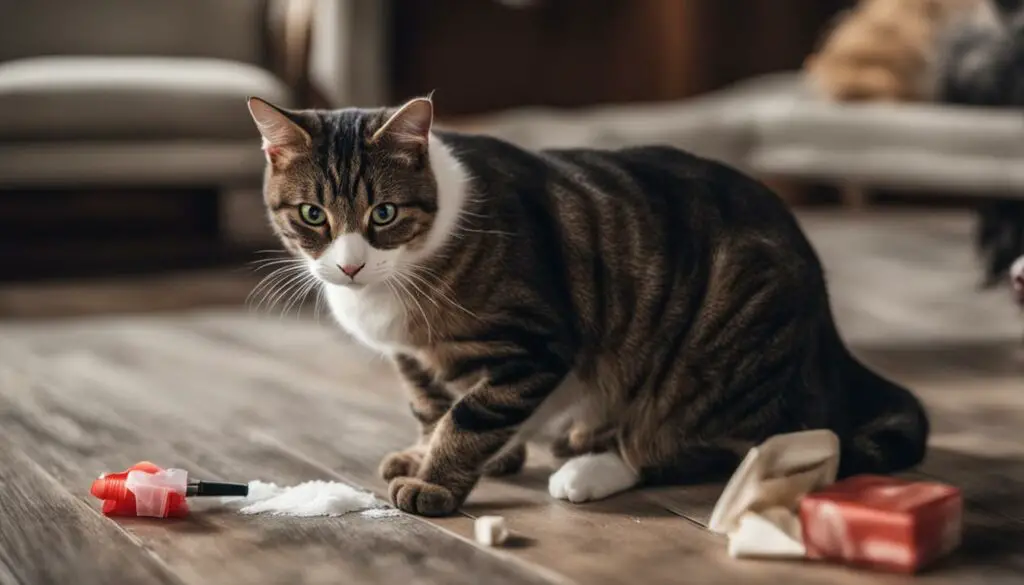
Preventing Cat Bites
To minimize the risk of cat bites, it’s important to understand your cat’s body language and behavior. Recognize signs of stress or aggression, such as flattened ears, dilated pupils, or hissing, and give your cat space when they display these behaviors.
Regular veterinary check-ups, vaccinations, and proper socialization can also reduce the likelihood of aggressive behavior. Providing your cat with appropriate toys, scratching posts, and outlets for play and exercise can help redirect their energy and prevent biting due to boredom or frustration.
By creating a safe and stimulating environment and understanding your cat’s needs, you can foster a healthier and more harmonious relationship, minimizing the occurrence of cat bites.
Socialization and Training Techniques
When it comes to addressing biting behaviors in cats, socialization and training play a crucial role. By providing positive interactions and reward-based training, we can help our feline companions learn appropriate behaviors and develop a strong bond with us.
Starting socialization early is key to ensuring that cats grow up to be well-adjusted and friendly. Exposing kittens to different people, animals, and environments helps them become more confident and adaptable. Gradually introducing them to new experiences can prevent fear-based aggression and make them more comfortable in various situations.
The Benefits of Positive Interactions
Positive interactions are essential for building trust and reinforcing desirable behaviors in cats. By rewarding them with treats, praise, and playtime when they exhibit good behavior, we can encourage them to repeat those actions. Negative reinforcement, such as punishment or scolding, should be avoided, as it can lead to fear and aggression.
“Reward-based training involves using treats, toys, or other rewards to reinforce desired behaviors in cats.”
Reward-based training involves using treats, toys, or other rewards to reinforce desired behaviors in cats. For example, if your cat nibbles on your fingers, redirect their attention to a toy or a scratching post instead. When they engage with the alternative behavior, reward them with praise and a treat. Consistency is key in training, so be patient and persistent in reinforcing positive behaviors.
| Positive Interactions Techniques | Benefits |
|---|---|
| Reward-based training | Encourages cats to repeat desired behaviors |
| Providing interactive toys | Redirects attention and stimulates mental and physical activity |
| Creating a calm and safe environment | Reduces anxiety-related aggression |
Alongside training, providing interactive toys and creating a calm and safe environment are effective strategies. Interactive toys keep cats mentally and physically engaged, diverting their attention from nibbling on fingers. Additionally, a calm and safe environment reduces stress and anxiety, which can contribute to aggression.
By focusing on positive interactions, reward-based training, and creating a stimulating environment, we can help our cats develop good behavior habits and strengthen our bond with them. Remember to approach training with patience and consistency, and always consult a professional if you need further guidance.
Providing Enrichment and Stimulation
When it comes to cat behavior, providing enrichment and stimulation is crucial in preventing unwanted behaviors such as excessive nibbling on fingers. Cats are curious and intelligent animals that require mental and physical stimulation to keep them happy and fulfilled. By offering a variety of toys, engaging in interactive play sessions, and providing perching spots, we can help meet their natural instincts and keep them entertained.
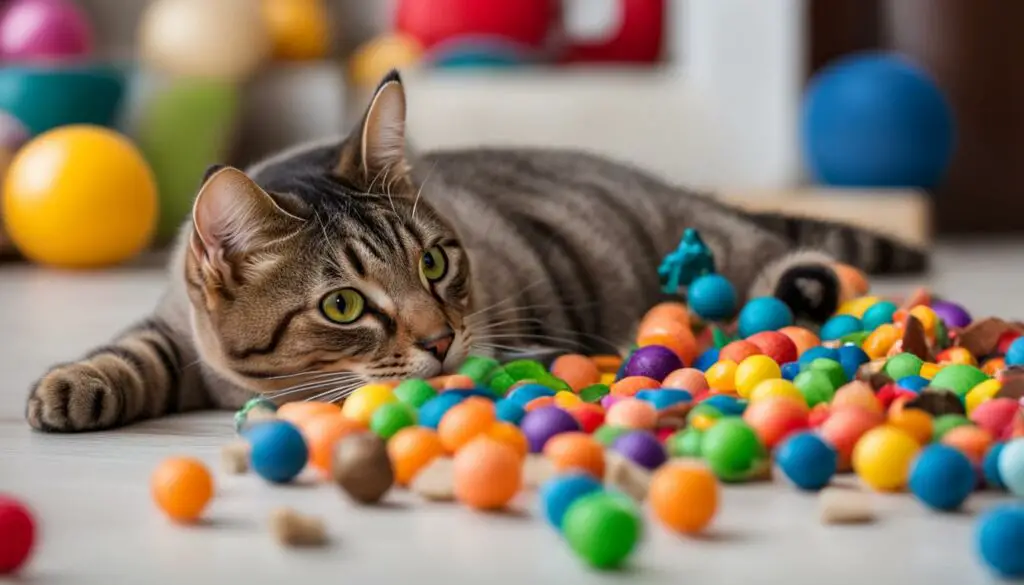
One way to provide enrichment is through interactive toys that engage a cat’s natural hunting instincts. Toys that mimic small prey, such as mice or birds, can be a great source of entertainment and mental stimulation. Additionally, puzzle toys that dispense treats or require problem-solving skills can keep cats engaged and mentally sharp. Remember to rotate toys regularly to keep their interest piqued.
In addition to toys, interactive play sessions are essential for a cat’s overall well-being. Use a wand toy or laser pointer to simulate prey-like movements and encourage your cat to chase and pounce. This type of play not only provides physical exercise but also helps strengthen the bond between you and your feline friend.
Finally, providing perching spots in your home can give your cat a sense of security and allow them to observe their surroundings from an elevated position. Whether it’s a cat tree, window perch, or designated shelves, these elevated spaces provide mental stimulation and a safe vantage point for your cat to satisfy their curiosity.
By incorporating these enrichment and stimulation techniques into your cat’s daily routine, you can help fulfill their natural instincts, prevent boredom, and reduce the likelihood of excessive nibbling on fingers. Remember, a happy and stimulated cat is a well-behaved and content companion.
Conclusion
Understanding why cats nibble on fingers is crucial for creating a strong bond with our feline companions. By delving into their natural behaviors and motivations, we can address and modify this behavior through behavior modification techniques.
Behavior modification involves providing enrichment and stimulation to keep cats mentally and physically engaged. By offering a variety of toys, interactive play sessions, and perching spots, we can redirect their attention and reduce the likelihood of excessive nibbling.
Positive reinforcement plays a vital role in training cats to adopt alternative behaviors. By rewarding desired actions with treats and praise, we can help cats associate these behaviors with positive outcomes. Consistency and patience are key when modifying cat behavior.
Building a deeper understanding of our feline friends allows us to communicate and connect with them on a profound level. By considering their innate behaviors and needs, we can ensure a harmonious and loving relationship with our cats while minimizing unwanted nibbling behaviors.
FAQ
Why does my cat nibble on my fingers?
Cats may nibble on fingers for various reasons, including curiosity, affection, grooming, and playfulness. Understanding these motivations can help you better communicate with your feline companion.
How do cats communicate?
Cats communicate through body language, social interactions, instinctual behaviors, and their environment. By understanding these aspects of cat behavior, you can gain insights into their nibbling behavior and other behaviors they exhibit.
What is body language and communication in cats?
Body language in cats includes tail positions, ear movements, and overall posture. By paying attention to these cues, you can better understand what your cat is trying to convey when they nibble on your fingers.
Do cats have social interactions and bonding?
Cats are both solitary and social animals. They establish hierarchies, territories, and form bonds within their social groups. Nibbling on fingers can be a way for cats to establish and strengthen their bond with their human companions.
Why do cats exhibit instinctual behaviors and playfulness?
Domesticated cats still retain many instinctual behaviors inherited from their wild ancestors. These behaviors include hunting, scratching, marking, and vocalizing. Nibbling on fingers can be a playful behavior that stems from their instinct to explore and engage in hunting-like behaviors.
How do environmental factors affect a cat’s behavior?
The environment plays a significant role in a cat’s behavior. Factors such as available resources, sensory stimuli, and overall comfort can impact their behavior. Cats may nibble on fingers as a way to seek comfort or alleviate stress in their environment.
Can health issues be a reason for cats to nibble on fingers?
In some cases, cats may nibble on fingers due to underlying health or dental issues. Teething, pain, or discomfort in the mouth can lead to excessive nibbling. It is important to monitor their oral health and seek veterinary attention if necessary.
Why do cats exhibit aggression and anxiety?
Cats may nibble on fingers as a defensive behavior when they feel threatened or anxious. Aggression can be a result of fear or unfamiliar situations. Proper socialization and creating a safe and calm environment can help reduce anxiety-related aggression.
Can boredom be a reason for cats to nibble on fingers?
Cats may nibble on fingers out of boredom or a lack of stimulation. Providing interactive toys and regular play sessions can help redirect their attention and prevent excessive nibbling due to boredom.
How can I train my cat to stop nibbling on fingers?
Training and behavior modification techniques can be used to discourage excessive nibbling on fingers. Using positive reinforcement, such as treats and praise, can help cats associate alternative behaviors with rewards. Consistency and patience are key when modifying cat behavior.
How should I handle cat bites?
Knowing how to handle cat bites is important to prevent infection and promote healing. Proper first aid steps should be followed, and seeking medical attention may be necessary in some cases. It is crucial to stay calm and take appropriate measures when dealing with a cat bite.
How can socialization and training techniques help prevent biting behaviors?
Proper socialization and training from an early age can help prevent biting behaviors in cats. Positive interactions, reward-based training, and providing stimulating environments can contribute to a well-behaved and happy cat.
What can I do to provide enrichment and stimulation for my cat?
Providing enrichment and stimulation is crucial in preventing biting behaviors. Offering a variety of toys, interactive play sessions, and perching spots can keep cats mentally and physically engaged, reducing the likelihood of excessive nibbling.
In conclusion, what should I take away about cat nibbling behavior?
Understanding why cats nibble on fingers is essential for building a strong bond with our feline companions. By considering their natural behaviors, providing enrichment, and using positive reinforcement, we can address and modify this behavior, leading to a more harmonious relationship.

